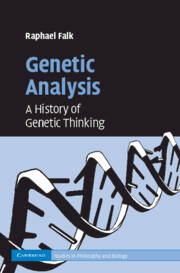Book contents
- Frontmatter
- Contents
- List of figures
- Acknowledgments
- Introduction
- PART I FROM REPRODUCTION AND GENERATION TO HEREDITY
- PART II FAKTOREN IN SEARCH OF MEANING
- PART III THE CHROMOSOME THEORY OF INHERITANCE
- PART IV GENES AS THE ATOMS OF HEREDITY
- PART V INCREASING RESOLVING POWER
- PART VI DEDUCING GENES FROM TRAITS, INDUCING TRAITS FROM GENES
- 14 How do genes do it?
- 15 The path from DNA to protein
- 16 Genes in the service of development
- PART VII WHAT IS TRUE FOR E. COLI IS NOT TRUE FOR THE ELEPHANT
- Concluding comments
- Bibliography
- Index
14 - How do genes do it?
Published online by Cambridge University Press: 07 August 2009
- Frontmatter
- Contents
- List of figures
- Acknowledgments
- Introduction
- PART I FROM REPRODUCTION AND GENERATION TO HEREDITY
- PART II FAKTOREN IN SEARCH OF MEANING
- PART III THE CHROMOSOME THEORY OF INHERITANCE
- PART IV GENES AS THE ATOMS OF HEREDITY
- PART V INCREASING RESOLVING POWER
- PART VI DEDUCING GENES FROM TRAITS, INDUCING TRAITS FROM GENES
- 14 How do genes do it?
- 15 The path from DNA to protein
- 16 Genes in the service of development
- PART VII WHAT IS TRUE FOR E. COLI IS NOT TRUE FOR THE ELEPHANT
- Concluding comments
- Bibliography
- Index
Summary
For Mendel the function of hereditary factors was a secondary issue. When he encountered the phenomena of dominating and recessivity he referred to them simply as facts that must be considered when dealing with the transmission of the factors:
Although the intermediate form of some of the more striking traits … is indeed nearly always seen, in other cases one of the two parental traits is so predominant that it is difficult, or quite impossible, to detect the other in the hybrid. … This is of great importance to the definition and classification of the forms in which the offspring of hybrids appear.
Mendel, in Stern and Sherwood (1966, 9, italics added)Mendel further emphasized that although “some of the more striking traits” show intermediate forms in hybrids, he deliberately selected for his experiments such traits that could be discerned qualitatively, so that he would be able to classify his data into binary categories (Falk, 2001a).
Not so for de Vries, for whom dominance was the clue to understanding function and development. He introduced his 1900 paper Das Spaltungsgesetz der Bastarde in terms of function rather than transmission:
According to pangenesis the total character of a plant is built up of distinct units. These so-called elements of the species, or its elementary characters, are conceived of as tied to bearers of matter, a special form of material bearer corresponding to each individual character. Like chemical molecules, these elements have no transitional stages between them.
de Vries, in Stern and Sherwood (1966, 107, italics added)- Type
- Chapter
- Information
- Genetic AnalysisA History of Genetic Thinking, pp. 211 - 219Publisher: Cambridge University PressPrint publication year: 2009



